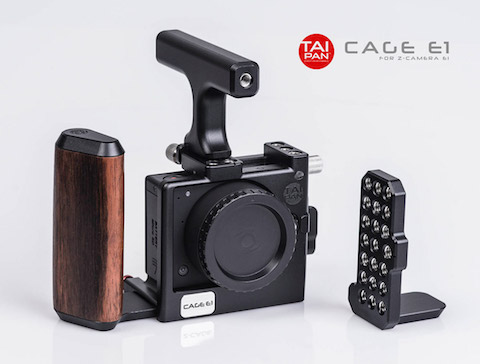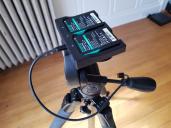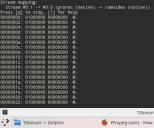
-
@zcream I followed the website instructions and had a result, but.. not easy to understand what it means. I'll post here the results, maybe someone can help!
-
I don't think it ever was on the start page, at least from the time I bought it for $199 Iast November. I would not be surprised if they stopped production even then. But the NX1 stopped production long ago, and it's still a good camera. Given the new battery availability, Z is evidently still providing support.
-
B&H Photo kept selling out the E1 and reordering. The last reorder was a few weeks ago. The E1 is now marked as a Top Seller. Normally, to keep costs down, factories in Shenzhen do not have stockpiles of product on the shelves, but made to order.
New Taipan Cinema Cage for E1
http://www.taipancinema.com/cage-e1-for-z-cam-e1/


 taipan E1.jpg480 x 364 - 32K
taipan E1.jpg480 x 364 - 32K -
Here is the charger for the Z Camera E1, now available directly from Yi (this has the two batteries already inserted). Nice and compact and light. Comes with micro-usb cable. The $75 kit (with two batteries) comes directly from Yi in Shenzhen by DHL, and I received it in three days after ordering (US). Shipping is free.

 Charger 2.jpg3024 x 2268 - 1M
Charger 2.jpg3024 x 2268 - 1M -
Check E2 interview closer to the end it has very nice news to E1 owners
-
Also look at cage in more detail
-
Good to hear another firmware update is coming for E1 owners, I wonder what it will be.
-
1080p120?
I've been trying to find the contents of the various firmware updates because I can't find a good review of the current state of the E1 on YouTube and I know it's different from when people initially canned it. Strongly considering grabbing one to mess with but there's just not a ton of info out there at least that I've found yet.
-
Need to ask Alan to make such video :-)
-
-
E2 looks very promissing for live brodcast, he said $1999???
-
Yes, one dollar under $2K
-
Beautiful the e2, but what about 12 or 14 bit modes and a professional video codec like the free cineform or $20 licensed cineform raw Bayer? Those would be good. Also BM has people making attachments for the interface on it's micro camera. If the same could be supported, those attachments could work with this? The attachments make a proper handheld camera rig out if the micro. A lot of stuff being designed by users.
Anyway, back to the E1. How difficult is it for them to upgrade the firmware to produce a clean 4k output 10 bit+, maybe 50fps, or to overclock the data rate and frame rate? If it could also be made to work with the BM.micro equipment, it would be fairly descent too. Just upgrading a clean 4k hdmi makes it suitable to use with the BM video assistant series or other, as a camera rig.
-
It's not usually possible to improve HDMI output like that with a software update.
Also, even if they could, what would be the incentive for them to add those features to a $200 camera and make it compete somewhat with their soon-to-be-released $2000 one?
-
Of course I'm taking about an update.
Building brand loyality.
Do you really.think that is going be very.good compared to the other?
-
Regardless, it's unlikely that the HDMI port on the original camera is capable of putting out a 4k 10-bit image.
-
As a current E1 user, I think we should be pushing for the raw go pro cineform update stated by @mei. 50 mbps 4k raw. Shouldn't be a problem bit rate wise. My Hdmi on my e1 is shaky at best. Def needs a firmware update for cheaper monitor solutions i.e lillput and feelword monitors if possible.... I like this camera for some reason. When i look at the 4kdci playback next to the ursa, I think "its really not that bad" lol. I'm just praying for about another 20 to 30 bits. I will post some footage soon but, We Really should bother kinson on Facebook about the Cineform!
-
Or invite him to this thread
-
Good thing to understand that it is all hardware limited.
-
@mikerandy. I was talking about the e2 using cineform. There is no real hope of getting e1 to do it, apart from remaking the camera, or using it for stills only. Clean improved HDMI output to a cheap recorder display using CEC remote control commands is the best way. Unfortunately there is no $100 HDMI recording dongle with card slot.
The chip in the e1 is likely an early ambarella one with little horsepower )maybe it can be driven a bit more) and likely very little hardware which could be used towards a professional codec. So, stills and waiting for it, is maybe the best.
The e2 is said to have something powerful and reprogrammable
-
back to the E1, I tried what @eatstoomuchjam suggested under linux, following the instructions on ffmpeg forum by David Rice:
I pipe the data to xxd for this, such as: ffmpeg -i v210.mov -c:v rawvideo -f rawvideo - | xxd -c 2 -b
Since the rawvideo of v210 is 16 bits, I use -c 2 to show the output in 2 bytes per row (-c 2). You’ll get an output that looks like this:
008322e: 11011101 00000001 0083230: 01001000 00000010 In the case I’ll see the last two (right most) bits of the first byte toggling indicated that it is actually using 10 bits of detail. If the v210 was 8 plus two zeros then the last two bits of the first byte would always be zero. Unfortunately there is a lot of video hardware that works as 8 bits so often those who are intending to digitize analog video to 10 bit are actually creating 10 bit files with the least significant bits simply being padding. Some digital videotapes also decode to 8 bit but are received over 10 bit SDI so this same process can be used to verify if the SDI contains actual 10 bit video or some amount of padding.
And I got the attached result for the first lines. But, not being a programmer, I wonder if things must be differntly, because atomos records in 10 bits and not 16 as the above example by David Rice.. Someone can give any hint?

 10bit.jpg494 x 410 - 43K
10bit.jpg494 x 410 - 43K -
I guess a non-scientific test would be to record an exposure chart simultaneously internally and to an external recorder. If you see more of the chart on the external screen, great.
-
That would be a good test.. unfortunately I don't own the E1, I did the test on @markr041 file.
-
Now I am curious... I noticed when testing something else today that my PIX-E5 displays the type of input signal that it is receiving. From my GH5, it is UHD 10-bit, from my A7r III, it is 1080p60 8-bit... from the E1, it is shown as 1080p60 12-bit? The camera could just be sending 8 bits of data in a 12-bit signal, though.
I don't know if I have any exposure charts handy, but I'll see if I can dig one up.
Howdy, Stranger!
It looks like you're new here. If you want to get involved, click one of these buttons!
Categories
- Topics List23,992
- Blog5,725
- General and News1,354
- Hacks and Patches1,153
- ↳ Top Settings33
- ↳ Beginners256
- ↳ Archives402
- ↳ Hacks News and Development56
- Cameras2,367
- ↳ Panasonic995
- ↳ Canon118
- ↳ Sony156
- ↳ Nikon96
- ↳ Pentax and Samsung70
- ↳ Olympus and Fujifilm101
- ↳ Compacts and Camcorders300
- ↳ Smartphones for video97
- ↳ Pro Video Cameras191
- ↳ BlackMagic and other raw cameras116
- Skill1,960
- ↳ Business and distribution66
- ↳ Preparation, scripts and legal38
- ↳ Art149
- ↳ Import, Convert, Exporting291
- ↳ Editors191
- ↳ Effects and stunts115
- ↳ Color grading197
- ↳ Sound and Music280
- ↳ Lighting96
- ↳ Software and storage tips266
- Gear5,420
- ↳ Filters, Adapters, Matte boxes344
- ↳ Lenses1,582
- ↳ Follow focus and gears93
- ↳ Sound499
- ↳ Lighting gear314
- ↳ Camera movement230
- ↳ Gimbals and copters302
- ↳ Rigs and related stuff273
- ↳ Power solutions83
- ↳ Monitors and viewfinders340
- ↳ Tripods and fluid heads139
- ↳ Storage286
- ↳ Computers and studio gear560
- ↳ VR and 3D248
- Showcase1,859
- Marketplace2,834
- Offtopic1,320






